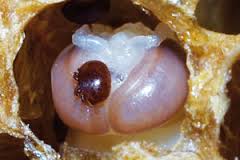Beekeepers MUST work in the spring to keep mite numbers low in September and October. The concept: if we flatten the mite growth curve in the spring their eventual population will not be as large and the harmful viruses they foster will mean less fall colony collapse and overwinter colony losses. Read to end for how to flatten mite growth in the spring.
It seems varroa mites are using drone brood to grow their spring population, based on new research from University of Maryland (Zachary Lamas), yet to be published. Dr Lamas’ study demonstrates the early spring reproducing female mites are primarily in drone brood. The research shows not mite bombs, nor robbing leads to high mite counts in the fall. It turns out the mites are hiding in plain sight, reproducing in drone brood of expanding spring colonies. We miss “seeing” them because, significantly, the mites are not randomly distributed.
A recent Bee Informed Partnership (BIP) blog emphasized the importance of spring mite control .(https://beeinformed.org/2023/03/01/the-importance-of-spring-mite-loads/) Proactively attacking the mite buildup in the spring translates into colonies never suffering the high mite numbers found in the fall when brood rearing slows and the number of mites on adult workers (the phoretic mites sampled through alcohol/powdered sugar mite sampling) all of a sudden “explode”. High mite numbers translate into the greater probability of Deformed Wing Virus (DWV) or the Paralysis viruses significantly shortening adult bee life and colonies not surviving winter.
Backyard beekeepers (those who maintain less than 50 colonies) have an annual 40% winter loss in Oregon. Commercial beekeepers who have low (~20%) losses year after year, achieve only ½ the losses of backyarders via 2 routes: 1) stock selection and 2) heavy use of amitraz. Unfortunately, the latter is coming back to “bite them” as those beekeepers who have used amitraz 4-5 times a year, mixing their own formulations from the chemical, are those who have the highest amitraz resistance according to Frank Rinkovich of Baton Rouge USDA lab. Amitraz is the only synthetic miticide available for mite control.
Those individuals who have the best overwintering success are likely to be those who suffered heavy losses for several years but who have continued to select local stock. Individuals living in areas where they are the principal beekeeper, have colonies with drone populations from their selected stock and they have the best overwintering success. Their virgin queen matings are primarily with the drones from their stock. The uncapping (hygienic) behavior, the main way bees fight the mites, is “lost” very quickly from a stock (it turns out) unless drone matings are with selected stock.
So what works to flatten the spring mite growth?
Apivar is still a valuable chemical alternative to varroa mite control where it has not been used exclusively to control mites for multiple years. The colonies used to generate the nucs and packages used to start a colony this April/May have likely been treated with Apivar by the beekeeper making up the nucs/packages. If individuals wish to treat their newly started colonies with Apivar they should ask the supplier if they have already been treated with Apivar. If yes or unknown, Apivar might be a better choice to use in the fall. The label does permit 2 applications/year.
.
For overwintered colonies, Apivar needs to be used early as treatment requires 6 weeks in the colony and a waiting period of 2 weeks before supering (for harvestable surplus honey). Use in early March would mean holding off on supering until end of April (8 weeks). In some springs/locations, strong colonies might need a super mid-April especially if you hope to capture big leaf maple surplus.
What might be a chemical alternative? The essential oil thymol (ApilLifeVar or Apiguard), once temperatures get to 65 F. or Formic acid (FormicPro). The formic acid ½ dosage application would be better than full doe as you can use even supers are on and it is less likely to result in queen death or stoppage in queen egg laying. You can also use the Apiguard thymol at ½ dosage.
Since drone brood is action central for early spring population growth of mites, drone brood removal is an effective non-chemical means of flattening the mite growth curve. Using this technique, you control where bees rear drones. Then by removing the capped drones before the adults emerge, any cells that have reproducing mites will be eliminated. You have prevented that female mite from reproducing 2 or more offspring. It is proactive management – you the beekeeper are managing the mites rather than the mites managing you (and their host bees).
Another non chemical mite control is to split (divide) colonies. As soon as queen cells are noted (in strongest colonies), splitting will be a method to reduce the probability of swarming. One or more of the divisions with minimal capped brood can be treated with oxalic acid (dribble or vaporization)and splits without the queen will have a period when there is no capped brood to treat with oxalic acid. It is a much more difficult management but both control of swarming and mite control can be achieved by splitting.
We MUST work in spring to keep mite numbers low in September and October. We need to flatten the mite growth curve so the eventual mite population will not be as great. It is hard to bring down high mite numbers in the fall – work to keep the numbers low for best success.
P.S. Randy Oliver of Scientific beekeeping has constructed a model that captures the importance of early intervention and keeping overall mite population low.
Randy’s Varroa model. Scientific Beekeeping. Retrieved March 4, 2023, from https://scientificbeekeeping.com/randys-varroa-model/

